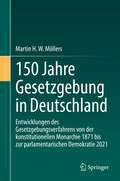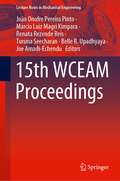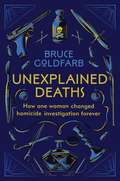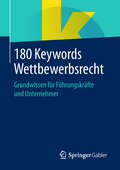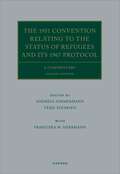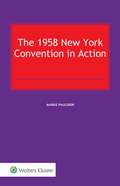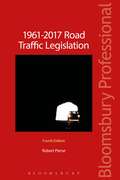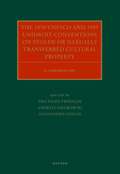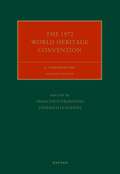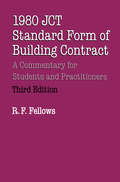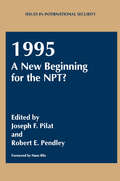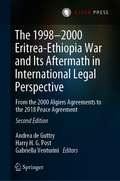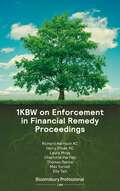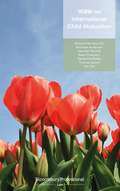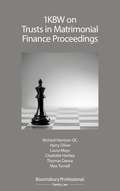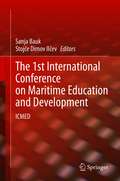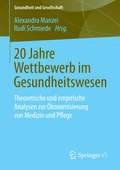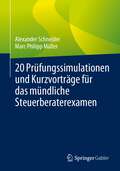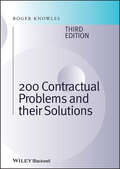- Table View
- List View
150 Jahre Gesetzgebung in Deutschland: Entwicklungen des Gesetzgebungsverfahrens von der konstitutionellen Monarchie 1871 bis zur parlamentarischen Demokratie 2021
by Martin H. MöllersDieses Buch erläutert die verfassungsmäßige Ausgestaltung der Gesetzgebungsverfahren im Kaiserreich, in der Weimarer Republik und in der Bundesrepublik Deutschland im Zusammenhang. Dadurch wird nachvollziehbar, dass die Gesetzgebung der heutigen parlamentarischen Demokratie ihre Basis bereits in der konstitutionellen Monarchie des Deutschen Kaiserreichs vor 150 Jahren hat. Obwohl das Verfahren der Gesetzgebung im Kaiserreich vordemokratisch ausgestaltet war, sind ihre wesentlichen Merkmale bis heute unverändert. Welche Änderungen die Gesetzgebungsverfahren von Verfassung zu Verfassung im Einzelnen erfuhren, analysiert das Buch und stellt heraus, dass diese Änderungen vor allem das Bund-Länder-Verhältnis, die Volkssouveränität sowie den Einfluss der Grundrechte auf die Gesetzgebung betrafen. Dabei kommen auch Auffassungen der Staatsrechtslehre früherer Zeiten zur Rechtsstaatlichkeit zur Sprache, die immer noch zum derzeitigen Meinungsspektrum zählen, heute jedoch nicht mehr zu halten sind. Zudem dokumentiert das Buch, wer an den Gesetzgebungsverfahren offiziell und wer faktisch beteiligt war bzw. noch ist und welche politischen Einflussnahmen auf die Gesetzgebung im Lauf der Geschichte festzustellen sind. So wird u.a. dokumentiert, dass insbesondere der Mangel an Transparenz der Zusammenarbeit von Exekutive und Legislative mit Lobbyisten dazu führt, dass viele Gesetze einzelne Bevölkerungsgruppen oder Wirtschaftszweige bevorzugen.
15th WCEAM Proceedings (Lecture Notes in Mechanical Engineering)
by João Onofre Pereira Pinto Marcio Luiz Magri Kimpara Renata Rezende Reis Turuna Seecharan Belle R. Upadhyaya Joe Amadi-EchenduThis book gathers selected peer-reviewed papers from the 15th World Congress on Engineering Asset Management (WCEAM), which was hosted by The Federal University of Mato Grosso do Sul Campo Grande, Brazil, from 15–-18 August 2021This book covers a wide range of topics in engineering asset management, including: strategy and standards;sustainability and resiliency;servitisation and Industry 4.0 business models;asset information systems; andasset management decision-making. The breadth and depth of these state-of-the-art, comprehensive proceedings make them an excellent resource for asset management practitioners, researchers, and academics, as well as undergraduate and postgraduate students.
18 Tiny Deaths: The Untold Story of Frances Glessner Lee and the Invention of Modern Forensics
by Bruce GoldfarbFor most of human history, sudden and unexpected deaths of a suspicious nature, when they were investigated at all, were examined by lay persons without any formal training. People often got away with murder. Modern forensic investigation originates with Frances Glessner Lee - a pivotal figure in police science.Frances Glessner Lee (1878-1962), born a socialite to a wealthy and influential Chicago family, was never meant to have a career, let alone one steeped in death and depravity. Yet she became the mother of modern forensics and was instrumental in elevating homicide investigation to a scientific discipline. Frances Glessner Lee learned forensic science under the tutelage of pioneering medical examiner Magrath - he told her about his cases, gave her access to the autopsy room to observe post-mortems and taught her about poisons and patterns of injury. A voracious reader too, Lee acquired and read books on criminology and forensic science - eventually establishing the largest library of legal medicine. Lee went on to create The Nutshell Studies of Unexplained Death - a series of dollhouse-sized crime scene dioramas depicting the facts of actual cases in exquisitely detailed miniature - and perhaps the thing she is most famous for. Celebrated by artists, miniaturists and scientists, the Nutshell Studies are a singularly unusual collection. They were first used as a teaching tool in homicide seminars at Harvard Medical School in the 1930s, and then in 1945 the homicide seminar for police detectives that is the longest-running and still the highest-regarded training of its kind in America. Both of which were established by the pioneering Lee.In 18 Tiny Deaths, Bruce Goldfarb weaves Lee's remarkable story with the advances in forensics made in her lifetime to tell the tale of the birth of modern forensics.
180 Keywords Wettbewerbsrecht: Grundwissen für Führungskräfte und Unternehmer
by Springer Fachmedien WiesbadenVon Absatzbindung über Neo-Schumpeter-Hypothesen bis Zollkartell: Die Sprache des Wettbewerbsrechts kennt unzählige Fachtermini. Einen ersten schnellen Überblick verschafft das vorliegende Nachschlagewerk, das anhand von 180 Schlüsselbegriffen die Grundlagen erläutert. Die Erklärungen sind kompakt und verständlich formuliert und bieten somit Basiswissen für alle, die einen schnellen Einstieg in die Praxis suchen, sich für das Wettbewerbsrecht interessieren oder ihr vorhandenes Wissen auffrischen wollen.
The 1951 Convention Relating to the Status of Refugees and its 1967 Protocol 2e (Oxford Commentaries on International Law)
by Andreas Zimmermann Terje Einarsen Franziska HerrmannThe Convention Relating to the Status of Refugees adopted on 28 July 1951 in Geneva continues to provide the most comprehensive codification of the rights of refugees yet attempted. Consolidating previous international instruments relating to refugees, the 1951 Convention with its 1967 Protocol marks a cornerstone in the development of international refugee law. At present, there are 149 States Parties to one or both of these instruments, expressing a worldwide consensus on the definition of the term refugee and the fundamental rights to be granted to refugees. These facts demonstrate and underline the extraordinary significance of these instruments as the indispensable legal basis of international refugee law. This Commentary provides for a systematic and comprehensive analysis of the 1951 Convention and the 1967 Protocol on an article-by-article basis, exposing the interrelationship between the different articles and discussing the latest developments in international refugee law. In addition, several thematic contributions analyse questions of international refugee law which are of general significance, such as regional developments, the interrelationship between refugee law and general human rights law, as well as the relationship between refugee law and the law of the sea.
The 1951 Convention Relating to the Status of Refugees and its 1967 Protocol 2e (Oxford Commentaries on International Law)
by Andreas Zimmermann Terje Einarsen Franziska M. HerrmannThe Convention Relating to the Status of Refugees adopted on 28 July 1951 in Geneva continues to provide the most comprehensive codification of the rights of refugees yet attempted. Consolidating previous international instruments relating to refugees, the 1951 Convention with its 1967 Protocol marks a cornerstone in the development of international refugee law. At present, there are 149 States Parties to one or both of these instruments, expressing a worldwide consensus on the definition of the term refugee and the fundamental rights to be granted to refugees. These facts demonstrate and underline the extraordinary significance of these instruments as the indispensable legal basis of international refugee law. This Commentary provides for a systematic and comprehensive analysis of the 1951 Convention and the 1967 Protocol on an article-by-article basis, exposing the interrelationship between the different articles and discussing the latest developments in international refugee law. In addition, several thematic contributions analyse questions of international refugee law which are of general significance, such as regional developments, the interrelationship between refugee law and general human rights law, as well as the relationship between refugee law and the law of the sea.
The 1951 Convention Relating to the Status of Refugees and its 1967 Protocol 2e (Oxford Commentaries on International Law)
by Andreas Zimmermann Terje Einarsen Franziska M. HerrmannThe Convention Relating to the Status of Refugees adopted on 28 July 1951 in Geneva continues to provide the most comprehensive codification of the rights of refugees yet attempted. Consolidating previous international instruments relating to refugees, the 1951 Convention with its 1967 Protocol marks a cornerstone in the development of international refugee law. At present, there are 149 States Parties to one or both of these instruments, expressing a worldwide consensus on the definition of the term refugee and the fundamental rights to be granted to refugees. These facts demonstrate and underline the extraordinary significance of these instruments as the indispensable legal basis of international refugee law. This Commentary provides for a systematic and comprehensive analysis of the 1951 Convention and the 1967 Protocol on an article-by-article basis, exposing the interrelationship between the different articles and discussing the latest developments in international refugee law. In addition, several thematic contributions analyse questions of international refugee law which are of general significance, such as regional developments, the interrelationship between refugee law and general human rights law, as well as the relationship between refugee law and the law of the sea.
The 1958 New York Convention in Action
by Marike PaulssonThe 1958 New York Convention has been called the most effective instance of international legislation in the entire history of commercial law. However, the succinct text of the Convention leaves open a host of significant and complex questions, which may be, and have been, answered in a variety of ways; as difficult cases arise and demand solutions, they generate inconsistent outcomes. For all its remarkable success, the Convention has on occasion proved itself to be unreliable and unpredictable. This book simultaneously exposes the difficulties of the Convention and explores potential solutions. It examines each substantive article of the New York Convention in accordance with the following outline: • the text and its issues; • original intent; • the prism of the rules of interpretation of the Vienna Convention; • judicial outcomes; and • appraisal. By drawing on the Convention's drafting history in great detail, the book presents a coherent account of how the most frequently recurring interrogations about the text are reflected (or not) in judicial practice. The author studied more than 1,700 decisions rendered under the Convention since its inception in 1958 in order to provide a succinct selection of landmark cases per article. With its intense investigation of the complex reality underlying contracting States' commitment in principle and judicial application in fact, the author's judicial understanding of the Convention provides a clear conceptual framework that will help avoid outcomes at odds with the purposes of this important instrument. Lawyers and judges will rely on this book not only to situate the Convention in the national legal orders where it is intended to produce its effects, but also discover practical ways to respond to distinct questions of application.
1961-2017 Road Traffic Legislation: Annotated Legislation
by Robert Pierse1961-2017 Road Traffic Legislation sets out annotated road traffic legislation from 1961 to 2017 and covers all relevant case law and Statutory Instruments. Includes reference to litigation on intoxicants, dangerous driving and other areas of Road Traffic Law. This title covers both practice and procedure and each section is annotated fully and cross referenced.Road traffic law is a vital part of many smaller solicitors' firms' daily work and this title provides them with annotated legislation in an area rife with difficulty as the legislation is piecemeal and often contradictory. Many Statutory Instruments and Acts are created in this area: some enacted in full, others not. This book updates the practitioner on this thorny area of law and points them to relevant case law where necessary.
The 1970 UNESCO and 1995 UNIDROIT Conventions on Stolen or Illegally Transferred Cultural Property: A Commentary (Oxford Commentaries on International Cultural Heritage Law)
by Ana Filipa Vrdoljak Andrzej Jakubowski Alessandro ChechiThe illicit traffic in cultural objects is a grave concern to the general public and international community. The resulting cultural damage fuels debates on how best to regulate the trade in cultural objects and inform legal responses at all levels for the protection of movable cultural heritage. Treaties concerning the treatment of cultural objects during peacetime and war represent some of the earliest multilateral initiatives on cultural heritage in the modern era. They also remain some of the most deeply contested, representing shifting fault lines within the international community. Authored by leading scholars and practitioners from around the world, this Commentary is the first to cover the two leading multilateral treaties on movable cultural heritage in one volume: the Convention on the Means of Prohibiting and Preventing the Illicit Import, Export and Transfer of Ownership of Cultural Property adopted by UNESCO in 1970 and the Convention on Stolen or Illegally Exported Cultural Objects adopted by UNIDROIT in 1995. This Commentary is designed to be the authoritative text for academics, lawyers, policymakers, and diplomats on the protection and regulation of cultural objects. Encompassing both public and private international law rules on the trade in cultural objects, it provides a detailed historical and thematic overview. Drawing on the travaux preparatoires and intergovernmental and state practice over the last half century, the Commentary provides an article-by-article analysis of the interpretation and application of these treaties. The texts 1970 UNESCO and 1995 UNIDROIT Conventions are examined in the working context of other culture conventions including the World Heritage Convention and the Intangible Heritage Convention, as well as related fields of international law, such as international humanitarian law, international criminal law, human rights law, and international economic law. The volume also offers a critical examination of current trends and future directions which are informing the field.
The 1970 UNESCO and 1995 UNIDROIT Conventions on Stolen or Illegally Transferred Cultural Property: A Commentary (Oxford Commentaries on International Cultural Heritage Law)
by Ana Filipa Vrdoljak Andrzej Jakubowski Alessandro ChechiThe illicit traffic in cultural objects is a grave concern to the general public and international community. The resulting cultural damage fuels debates on how best to regulate the trade in cultural objects and inform legal responses at all levels for the protection of movable cultural heritage. Treaties concerning the treatment of cultural objects during peacetime and war represent some of the earliest multilateral initiatives on cultural heritage in the modern era. They also remain some of the most deeply contested, representing shifting fault lines within the international community. Authored by leading scholars and practitioners from around the world, this Commentary is the first to cover the two leading multilateral treaties on movable cultural heritage in one volume: the Convention on the Means of Prohibiting and Preventing the Illicit Import, Export and Transfer of Ownership of Cultural Property adopted by UNESCO in 1970 and the Convention on Stolen or Illegally Exported Cultural Objects adopted by UNIDROIT in 1995. This Commentary is designed to be the authoritative text for academics, lawyers, policymakers, and diplomats on the protection and regulation of cultural objects. Encompassing both public and private international law rules on the trade in cultural objects, it provides a detailed historical and thematic overview. Drawing on the travaux preparatoires and intergovernmental and state practice over the last half century, the Commentary provides an article-by-article analysis of the interpretation and application of these treaties. The texts 1970 UNESCO and 1995 UNIDROIT Conventions are examined in the working context of other culture conventions including the World Heritage Convention and the Intangible Heritage Convention, as well as related fields of international law, such as international humanitarian law, international criminal law, human rights law, and international economic law. The volume also offers a critical examination of current trends and future directions which are informing the field.
The 1972 World Heritage Convention: A Commentary (Oxford Commentaries on International Cultural Heritage Law)
by Prof Francesco Francioni Prof Federico LenzeriniAlmost fifty years have passed since the adoption of the Convention Concerning the Protection of the World Cultural and Natural Heritage (the UNESCO World Heritage Convention). With its 194 States Parties, it is the most widely ratified convention within the family of UNESCO treaties on the protection of cultural heritage. The success of this Convention and its almost universal acceptance by the international community of states is due to the great appeal that recognising certain properties as “world heritage” has for national governments. Since the publication of the first Commentary, new problems have arisen in the management of world heritage sites. It has become increasingly difficult to properly monitor the conservation of the ever-growing mass of sites inscribed in the World Heritage List, and to resolve disputes over the formal designation of contested world heritage properties - a problem that has led to the withdrawal of the United States and Israel from UNESCO. New frontiers are now being explored for the expansion of the world heritage idea over marine areas beyond national jurisdiction, and the monopoly of the State in the identification, delineation, and presentation of world heritage properties is being increasingly challenged in the name of indigenous peoples' rights and by local communities claiming ownership over contested cultural sites. At the same time, the regime of world heritage protection has infiltrated other areas of international law, especially international economic law, investment arbitration, and the area of international criminal law. This second edition critically examines the World Heritage Convention against this dynamic evolution of international heritage law to help academics, lawyers, diplomats, and officials interpret and apply the norms of the Convention after half a century of uninterrupted implementing practice by State Parties and Treaty Bodies.
The 1972 World Heritage Convention: A Commentary (Oxford Commentaries on International Cultural Heritage Law)
by Prof Francesco Francioni Prof Federico LenzeriniAlmost fifty years have passed since the adoption of the Convention Concerning the Protection of the World Cultural and Natural Heritage (the UNESCO World Heritage Convention). With its 194 States Parties, it is the most widely ratified convention within the family of UNESCO treaties on the protection of cultural heritage. The success of this Convention and its almost universal acceptance by the international community of states is due to the great appeal that recognising certain properties as “world heritage” has for national governments. Since the publication of the first Commentary, new problems have arisen in the management of world heritage sites. It has become increasingly difficult to properly monitor the conservation of the ever-growing mass of sites inscribed in the World Heritage List, and to resolve disputes over the formal designation of contested world heritage properties - a problem that has led to the withdrawal of the United States and Israel from UNESCO. New frontiers are now being explored for the expansion of the world heritage idea over marine areas beyond national jurisdiction, and the monopoly of the State in the identification, delineation, and presentation of world heritage properties is being increasingly challenged in the name of indigenous peoples' rights and by local communities claiming ownership over contested cultural sites. At the same time, the regime of world heritage protection has infiltrated other areas of international law, especially international economic law, investment arbitration, and the area of international criminal law. This second edition critically examines the World Heritage Convention against this dynamic evolution of international heritage law to help academics, lawyers, diplomats, and officials interpret and apply the norms of the Convention after half a century of uninterrupted implementing practice by State Parties and Treaty Bodies.
1980 JCT Standard Form of Building Contract: A Commentary for Students and Practitioners (Building and Surveying Series)
by Richard FellowsThis book analyses and comments on the 1980 JCT Standard Form of Building Contract, Private with Quantities Edition on a clause-by-clause basis, including notes on interpretation, legal precedents and information on the alternative editions of the Standard Form as well as the appropriate supplements. The third edition of this book incorporates the amendments published up to the end of November 1994 and updates the case law to include significant, recent precedents which supplement those included in the first two editions. Thus, this book will prove of use to many concerned with building, whether in industry or the professions commonly encountering problems of interpretation and implementation of the contract, or as students. The use of this book is recommended to be in conjunction with a copy of the appropriate JCT contract in order that the exact terminology of the document may be studied together with its interpretation. This is particularly important in practical situations where amendments to the contract vary the standard terms.
1984 Nineteen Eighty-Four: New Edition of the Twentieth Century’s Dystopian Masterpiece
by George OrwellTHE JURA EDITION with new introduction by Alex Massie'For him, Jura was home' - Richard Blair on his father George Orwell'The book of the twentieth century . . . haunts us with an ever-darker relevance’ - Ben Pimlott, Independent'The greatest British novel to have been written since the war’ - Time Out'His final masterpiece . . . enthralling and indispensable for understanding modern history' – New York Review of BooksThe year is 1984 and war and revolution have left the world unrecognisable. Great Britain, now known as Airstrip One, is ruled by the Party, led by Big Brother. Mass surveillance is everything and The Thought Police are employed to ensure that no individual thinking is allowed. Winston Smith works at The Ministry of Truth, carefully rewriting history, but he dreams of freedom and of rebellion.It is here that he meets and falls in love with Julia. They start a secret, forbidden affair - but nothing can be kept secret, and they are forced to face consequences more terrifying than either of them could have ever imagined.In this new edition of a modern classic, Alex Massie's introduction highlights the importance that Jura had on the writing of one of the twentieth century’s most important works of fiction.
1995: A New Beginning for the NPT? (Issues in International Security)
by Robert E. Pendley Joseph F. PilatAs a follow-up to Beyond 1995: The Future of NPT published in 1990, this compilation presents the major issues to be addressed at the 1995 NPT Review and Extension Conference. Renowned academic and diplomatic authorities from around the world contribute original essays and address questions such as: - Will the NPT be faced with a fundamental challege to its existence? - Will the treaty be allowed to lapse? - Will states withdraw? - Will the NPT be succeeded by an alternative treaty or regime?
The 1998–2000 Eritrea-Ethiopia War and Its Aftermath in International Legal Perspective: From the 2000 Algiers Agreements to the 2018 Peace Agreement
by Andrea De Guttry Harry H. G. Post Gabriella VenturiniThis book centres on the war that raged between Eritrea and Ethiopia from 1998 to 2000, a war that caused great loss of life and tremendous devastation. It analyses the war in great detail from an international legal perspective: the nature and the state of the boundary conflict preceding the actual armed conflict, the military actions themselves, the role of the UN peace-keeping mission, the responsibility for the multitude of explosive remnants of the war left behind. Ample attention is paid to the decisions of the Eritrea-Ethiopia Claims Commission and the Eritrea-Ethiopia Boundary Commission. This study is not limited to the war and the period immediately following it, it also examines its more extended aftermath prolonging the analysis as far as the more recent improvement in the relations between Eritrea and Ethiopia, away from a situation of ‘no war, no peace’ that prevailed after the armed conflict ended. The analysis of the war and its aftermath is not only in terms of international legal issues, it has been placed in a wider than strictly legal perspective. The book is a valuable work for academics and practitioners in international law, human rights and humanitarian law in particular, for political scientists, diplomats, civil servants, historians, and all those others seriously interested in the Horn of Africa. Andrea de Guttry is Full Professor of Public International Law at the Scuola Superiore Sant'Anna in Pisa, Italy. Harry H.G. Post is Adjunct Professor in the Faculté Libre de Droit of the Université Catholique de Lille in Lille, France. Gabriella Venturini is Professor Emerita in the Dipartimento di Studi internazionali, giuridici e storico-politici of the Università degli Studi di Milano in Milan, Italy.
1KBW on Enforcement in Financial Remedy Proceedings (1 KBW on)
by Richard Harrison KC Harry Oliver Laura Moys Charlotte Hartley Thomas Dance Max TurnellAlmost every contested financial case raises issues of enforcement. Even if these issues do not materialise, it is essential for practitioners to be alive to them when they are negotiating settlements or pursuing an application for financial orders. This work provides a comprehensive guide to enforcement issues both in terms of substantive and procedural law. It also covers international cases where especially difficult issues are often thrown up, offering practical guidance on how such issues might be addressed.The work covers:- General enforcement and specific orders under FPR 2010, Part 33- A range of orders including freezing orders, search orders and mandatory orders- Committal proceedings and sequestration- Obtaining a 'Hadkinson' order- Assets held in trust including 'sham' trusts- Enforcement of overseas orders- Issues thrown up by international casesWritten by specialist family barristers from 1KBW under the general editorship of Richard Harrison KC, this book provides guidance in and understanding of this complex area of law with flowcharts and tables, setting out challenging issues in a concise and digestible way.
1KBW on International Child Abduction (1 KBW on)
by Richard Harrison QC Nicholas Anderson Jennifer Perrins Katy Chokowry Samantha Ridley Thomas Dance Elle Tait1KBW on International Child Abduction is a guide to the practice and procedure in international child abduction proceedings, in particular applications under the 1980 Hague Convention. It provides guidance as to the law of England and Wales and relevant international law in child abduction cases, as well as the procedures for making applications inthe High Court and for pursuing appeals in the Court of Appeal and the Supreme Court. It condenses a large body of case law and international instruments into a digestible format, so that practitioners have all the tools needed for day-to-day practice in one place.1KBW on International Child Abduction provides:- Flow charts to explain key legal principles and procedural steps, as well as diagrams which summarise important cases- A dedicated section on the 1980 Hague Convention, with individual chapters devoted to key principles such as rights of custody, habitual residence and the relevant 'defences' to applications for a summary return order- Chapters pertaining to the 1996 Hague Convention and applications under the inherent jurisdiction- Practical guidance about the procedure for making applications in the High Court, such as: how to make urgent without notice applications; the criteria for obtaining different types of Tipstaff orders; and when to seek specific orders for disclosure to assist in tracing a child- A summary of Covid-19 guidanceLegislation and guidance covered includes:- 1980 Hague Convention- 1996 Hague Convention- Child Abduction and Custody Act 1985- Family Law Act 1986- President's Practice Guidance: Case Management and Mediation of International Child Abduction Proceedings1KBW on International Child Abduction is aimed primarily at practitioners who already specialise, or are looking to specialise, in international child abduction. It can also be used as a reference tool by all family practitioners and those who have an interest in the subject.
1KBW on Trusts in Matrimonial Finance Proceedings (1 KBW on)
by Richard Harrison QC Harry Oliver Laura Moys Charlotte Hartley Thomas Dance Max TurnellAre you working with trust assets and interests in the context of matrimonial and family finance disputes?A comprehensive guide to issues frequently arising in English matrimonial finance cases, where one or both spouses has an interest in, or access to, trust assets.Key topics covered include: Jurisdiction Service and joinder Nuptial settlements Trusts as resources EnforcementChapters summarise the key principles of English family finance and trust principles through diagrams, flowcharts and tables, alongside clear narrative, to ensure the more technical information is intelligible yet authoritative.An indispensable tool kit for English practitioners and judges working in the field of family finance, as well as those practising in other jurisdictions looking for an accessible guide to the English matrimonial arena. It also contains vital information for trust and corporate lawyers encountering matrimonial disputes when trustees are joined or otherwise intervene in family cases.
The 1st International Conference on Maritime Education and Development: ICMED
by Sanja Bauk Stojče Dimov IlčevThis book presents the proceedings of the 1st International Conference on Maritime Education and Development. The conference exchanges knowledge, experiences and ideas in the domain of maritime education and development, with the ultimate goal of generating new knowledge and implementing smart strategies and actions. Topics include the 4th Industrial Revolution (4IR); unmanned air/sea surface/underwater vehicles (UxV); the digital divide and Internet accessibility; digital infrastructure; IMO E-navigation strategy; smart-ship concept; automation and digitalization; cyber security; and maritime future. This proceedings pertains to researchers, academics, students, and professionals in the realm of maritime education and development.
20 Jahre Wettbewerb im Gesundheitswesen: Theoretische und empirische Analysen zur Ökonomisierung von Medizin und Pflege (Gesundheit und Gesellschaft)
by Alexandra Manzei Rudi SchmiedeWährend das Wettbewerbsparadigma in anderen gesellschaftlichen Teilbereichen spätestens nach der Finanzkrise 2009 nicht mehr unhinterfragt als Königsweg politischer Regulierung propagiert wird, scheint es in der Gesundheitspolitik völlig ungebrochen. Dies verwundert umso mehr, als mittlerweile zahlreiche empirische Studien vorliegen, die die problematischen Folgen der Ökonomisierung von Medizin und Pflege belegen. Intention des vorliegenden Bandes ist es, qualitative und quantitative Analysen zur Arbeits- und Lebenswirklichkeit von Beschäftigen und PatientInnen zu bündeln, sie durch Berichte aus der Praxis zu ergänzen und so einen umfassenden Einblick in die Realität des wettbewerbsgesteuerten Gesundheitswesens zu eröffnen.
20 Prüfungssimulationen und Kurzvorträge für das mündliche Steuerberaterexamen
by Alexander Schneider Marc Philipp MüllerDas Buch gibt den Ablauf einer mündlichen Prüfung eines Steuerberaterexamens realitätsnah wieder. Im gesamten Bundesgebiet besteht die mündliche Prüfung aus sechs Prüfungsabschnitten und einem kurzen Vortrag. In diesem Buch werden die sechs Prüfungsabschnitte in der üblichen Reihenfolge nachgebildet. So werden jeweils zwei Prüfungsabschnitte den Vertretern des Berufsstandes und der Finanzverwaltung zugeordnet. Jeweils ein Prüfungsabschnitt ist vorgesehen für den Vertreter der Wirtschaft sowie für den Prüfungsvorsitzenden, der üblicherweise aus der Finanzverwaltung kommt. Das Buch berücksichtigt die erhöhte Bedeutung der Prüfungsgebiete Berufsrecht, Wirtschaftsrecht und allgemeines Recht sowie Fragestellungen zu aktuellen steuerlichen Entwicklungen und betriebswirtschaftliche Themen. Bei den Kurzvorträgen liegt ein Schwerpunkt bei Themen des Zivilrechts, die erfahrungsgemäß häufig eines der drei Vortragthemen darstellen. Das Buch umfasst den Rechtsstand bis April 2023. Alle aktuellen Änderungen im Steuerrecht sind berücksichtigt und teilweise als Fragen in den Prüfungsabschnitten enthalten.Der InhaltAblauf der mündlichen Prüfung des Steuerberaterexamens20 PrüfungssimulationenZwei Teilbereiche für den Berufsstand und der FinanzverwaltungEin Teilbereich für den Vertreter der Wirtschaft und dem Vorsitzendem des Prüfungsausschusses20 VortragsthemenDie AutorenAlexander Schneider ist promovierter Rechtsanwalt, Fachanwalt für Steuerrecht, Steuerberater und Wirtschaftsprüfer. Er lehrt als Professor auf den Gebieten des Steuerrechts. Zudem ist er als Partner im Bereich Steuern für die BDO AG Wirtschaftsprüfungsgesellschaft AG und ist an der Steuerberaterkammer München seit mehr als 20 Jahren als Prüfer für das mündliche Steuerberaterexamen bestellt.Marc Philipp Müller ist Master of Science und Steuerberater. Er ist als Manager im Bereich Tax & Legal für die BDO AG Wirtschaftsprüfungsgesellschaft AG in München tätig. Er hat die mündliche Steuerberaterprüfung im April 2022 erfolgreich abgelegt und konnte daher seine frisch gesammelten Eindrücke und Erfahrungen in das vorliegende Vorbereitungsbuch einfließen lassen.
200 Contractual Problems and their Solutions
by J. Roger KnowlesThis book examines 200 contractual problems which regularly arise on building and engineering projects and provides a detailed explanation of their solutions, citing standard contract conditions and key parts of legal judgements as authority. A succinct summary is provided at the end of each detailed solution. It covers problems together with their solutions in respect of: Procurement matters Tenders and bidding Design issues Letters of intent Contractor's programme Contractor's float Delays Concurrent Delays Extensions of time Liquidated/delay damages Unliquidated damages Variations Loss and expense/additional cost claims Acceleration Global claims Payment Damage to the works Exclusion clauses Retention of title Practical completion Defect correction Adjudication This book deals with a broad range of construction contracts including JCT Standard Form and Design and Build, New Engineering Contract NEC3, ICE and GC/Works/1. This book was first published under the title of One Hundred Contractual Problems and Their Solutions, with a second edition entitled One Hundred and Fifty Contractual Problems and their Solutions. This third edition adds 50 new problems and replaces 15 of those in the last edition. Of the remainder half have been the subject of revision. "Deserves a place on every site and in every office as the standard handbook on contractual problems"—Construction Law Digest
200 Contractual Problems and their Solutions
by J. Roger KnowlesThis book examines 200 contractual problems which regularly arise on building and engineering projects and provides a detailed explanation of their solutions, citing standard contract conditions and key parts of legal judgements as authority. A succinct summary is provided at the end of each detailed solution. It covers problems together with their solutions in respect of: Procurement matters Tenders and bidding Design issues Letters of intent Contractor's programme Contractor's float Delays Concurrent Delays Extensions of time Liquidated/delay damages Unliquidated damages Variations Loss and expense/additional cost claims Acceleration Global claims Payment Damage to the works Exclusion clauses Retention of title Practical completion Defect correction Adjudication This book deals with a broad range of construction contracts including JCT Standard Form and Design and Build, New Engineering Contract NEC3, ICE and GC/Works/1. This book was first published under the title of One Hundred Contractual Problems and Their Solutions, with a second edition entitled One Hundred and Fifty Contractual Problems and their Solutions. This third edition adds 50 new problems and replaces 15 of those in the last edition. Of the remainder half have been the subject of revision. "Deserves a place on every site and in every office as the standard handbook on contractual problems"—Construction Law Digest
